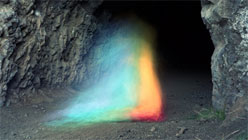In the rear of the gallery, Nicole Fein’s delicate tabletop paintings stand in a rigid arrangement. Each contains a grid of dots, with impeccably applied ink that swirls shadows in perfect patterns as though the dots were the heads of nails whose shafts cannot be seen. In another context, these three works would be algorithmic games, but here, they are sundials. They play with the eye, forcing it into swirling patterns across the paintings. The view is dizzying, remarkably so because, despite any experiential notion you may have, the dots remain static.
During the opening, seven performers in black pushed their backs against The LAB’s square columns in a strenuous wall-sit for Michael Namkung’s Column Sit. They marked the wall above their heads with a large piece of graphite in each hand until one-by-one they collapsed from fatigue. Namkung also performed. I asked him how time passing changes during a performance. “Time falls away the way we normally experience it, and as you tune into the rhythms of your body, your breathing and the sounds that your body makes, those become statements for time.” There was something enchanting about seeing how seven different individuals dealt with pain, and how their strategies — one man kept his eyes closed and made perfectly vertical marks, while another kept blinking exaggeratedly while scribbling erratic shapes — resulted in seven very different drawings.
Brice Bischoff’s performed photographs at the Bronson Caves bring fluorescent color to a largely monochrome exhibition. Bischoff explained that these are site-specific works because the Bronson Caves have starred in countless films and television shows due to their proximity to Hollywood, but the photographs are more striking for their heavy contrast and technique — layers of color fields that fade into the rough-hewn surface of ashen stone. These are performances that are “meant to be experienced as a photograph,” Bischoff said. “I was seeing [the performance] how the camera would see it.”

Scott Kildall’s instructions on how to build a machine to contact anyone anywhere in Universal Mailbox (detail) 2011.
Comedic timing is also key in the exhibition. In one of Kevin Seaman’s “Living Photograph” series — Bathtub Marilyn Monroe (2010), the naked, bearded artist poses in a bathtub covered extravagantly in bubbles beaming a cover-worthy smile. He sinks slowly with the bubbles, and the image shifts back and forth between still and living. Scott Kildall presents Universal Mailbox (2011), which he describes as “a device that can send a message to any person in any universe at any time.” And though the Universal Mailbox is not unlike a device cooked up by Wile E. Coyote, blueprints and all, there are already notes pinned to the wall written by hopeful visitors (a message to David Lynch, addressed Los Angeles, dated a hundred years in the future: “How did you survive?”)

Angela Willetts and Todd Anderson, InkSpace/InkTime 2011.
Taken individually, the works in Time are each worthy of consideration, but the diversity of media and approach to the subject make it a challenge to see them all in one go. In Ashley Lauren Saks’s Celular Roto (Broken Cellphone) (2010) strangers are convinced to reenact in repetitions a mundane taxicab conversation. Surabhi Saraf presents video of public performances that have engaged over 60 volunteers to fold clothing in slow, loosely choreographed cycles through the project FOLD {Live} (2011). Adam Katseff’s immaculate photographs of flames are mystic in their asceticism: black and white, they are a record of light, carbon, and fire. And it might be easy to overlook that Angela Willetts and Todd Anderson’s sculpture InkSpace/InkTime (2011) is a three-dimensional map of the two-dimensional painting hanging above it, retold through time. “Time became the depth of the piece,” Willetts told me, and while I’m sure she meant it quite literally, the same could be said of each of this show’s intricate works.
Time was curated by Gail Dawson, Mary Anne Kluth, and Jesse Holding, and is on view through October 29, 2011 at The LAB. For more information visit thelab.org.
Images c. the artists, and appear courtesy The LAB, San Francisco.





